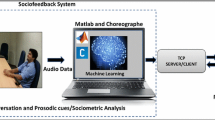Abstract
This paper proposes a novel utterance generation mechanism for a Talking-Ally robot through the utilization of the concepts of hearership and addressivity. The approach incorporates an addressee’s eye-gaze behaviors (state of hearership) in order to produce the utterances (addressivity) necessary for achieving smooth communication (synchronized with bodily interactions), which are perceived as being persuasive by the addressee. The results of the study show that the resources of the hearer were significant in generating or adjusting to the structure of utterances in order to persuade the addressee. Additionally, an analysis of dynamic interactions revealed that both the human and robot influenced each other’s behaviors—e.g., the robot influenced the addressee’s attention and the human influenced the robot in changing its utterances. The results of a subjective rating indicated that the robot recognized the participants as hearers, and it was also capable of utterance generation and behaved autonomously (robotic life-likeness), which proved to be crucial in enhancing the persuasiveness of the robot’s communication.









Similar content being viewed by others
References
Ford CE, Thompson SA (1996) Interactional units in conversation: syntactic, intonational, and pragmatic resources for the management of turns. Stud Interact Socioling 13:134–184
Ford M, Cook M (1976) Gaze and mutual gaze. Cambridge University Press, Cambridge
Fogg B (1998) Persuasive computers: perspectives and research directions. In: Proceedings of the SIGCHI conference on human factors in computing systems, CHI ’98, pp 225–232
Ham J, Bokhorst R, Cuijpers RH, van der Pol D, Cabibihan J-J (2011) Making robots persuasive: the influence of combining persuasive strategies (gazing and gestures) by a storytelling robot on its persuasive power. In: ICSR, pp 71–83
Looije R, Neerincx MA, Cnossen F (2010) Persuasive robotic assistant for health self-management of older adults: design and evaluation of social behaviors. Int J Hum-Comput Stud 68(6):386–397
Siegel M, Breazeal C, Norton MI (2009) Persuasive robotics: the influence of robot gender on human behavior. In: IROS, pp 2563–2568
Roubroeks MAJ, Ham J, Midden CJH (2011) When artificial social agents try to persuade people: the role of social agency on the occurrence of psychological reactance. Int J Soc Robot 3(2):155–165
Ham J, Midden CJH (2010) Ambient persuasive technology needs little cognitive effort: the differential effects of cognitive load on lighting feedback versus factual feedback. In: PERSUASIVE, pp 132–142
D’Mello S, McCauley L, Markham J (2005) A mechanism for human–robot interaction through informal voice commands. In: Robot and human interactive communication, 2005. ROMAN 2005. IEEE international workshop on, pp 184–189
Sidner CL, Lee C, Morency L-P, Forlines C (2006) The effect of head-nod recognition in human–robot conversation. In: HRI, pp 290–296
Mutlu B, Kanda T, Forlizzi J, Hodgins JK, Ishiguro H (2012) Conversational gaze mechanisms for humanlike robots. TiiS 1(2):12
Iwamura Y, Shiomi M, Kanda T, Ishiguro H, Hagita N (2011) Do elderly people prefer a conversational humanoid as a shopping assistant partner in supermarkets? In: HRI, pp 449–456
Okada M (1995) Why doesn’t the computer speak with hesitation. Kyoritsu Shuppan, Tokyo
Goodwin C (2009) Embodied hearers and speakers constructing talk and action in interaction. Wadsworth, Belmont, pp 51–64
Bakhtin M (1986) The problem of speech genres. University of Texas Press, Austin, pp 60–102
Okada M, Kurihara S, Nakatsu R (1994) Incremental elaboration in generating and interpreting spontaneous speech. In: Proceedings of 3rd international conference on spoken language processing, pp 103–106
Damiano L, Dumouchel P, Lehmann H (2012) Should empathic social robots have interiority? In: ICSR, pages 268–277
Mccroskey JC, Sallinen A, Fayer JM, Richmond VP, Barraclough RA (1996) Nonverbal immediacy and cognitive learning: a cross-cultural investigation. Commun Educ 45(3):200–211
Chidambaram V, Chiang Y-H, Mutlu B (2012) Designing persuasive robots: how robots might persuade people using vocal and nonverbal cues. In: HRI, pp 293–300
Gibbs RW (2005) Embodiment and cognitive science. Cambridge University Press, Cambridge
Seeing Machine, FaceLab face and eye tracking system (2004) http://www.seeingmachines.com. Canberra ACT 2601
Lutz R, Swasy JL (1977) Integrating cognitive structure and cognitive response approaches to monitoring communications effects. Assoc Consum Res 4(1):363–371
Kuijlaars ABJ (2001) Book review: “a course in approximation theory” by ward cheney and will light. J Approx Theory 112(2):318
Acknowledgments
This research has been supported by both Grant-in-Aid for scientific research of KIBAN-B (26280102) and Grant-in-Aid for scientific research for HOUGA (24650053) from the Japan Society for the Promotion of Science (JSPS).
Author information
Authors and Affiliations
Corresponding author
Rights and permissions
About this article
Cite this article
Ohshima, N., Ohyama, Y., Odahara, Y. et al. Talking-Ally: The Influence of Robot Utterance Generation Mechanism on Hearer Behaviors. Int J of Soc Robotics 7, 51–62 (2015). https://doi.org/10.1007/s12369-014-0273-8
Accepted:
Published:
Issue Date:
DOI: https://doi.org/10.1007/s12369-014-0273-8




